- Publisher's Note
- Editorial
- Love of Life (that) Spills Over
- A Continuing Multiplication
- From Painting to Print
- Intimate Involvement
- Portrait of the Artist as an Old Man
- (Hi)Story of the Garhi Printmaking Studios, New Delhi
- Surinder Chadda
- Ramendranath Chakravorty
- Group 8
- Mother and Child: A Screenplay
- Straddling Worlds
- A Brief History of Printmaking at Santiniketan
- Vignettes from History
- Southern Strategies
- The Forgotten Pioneer: Rasiklal Parikh
- Printmaking in the City Of Joy
- Amitabha Banerjee: His Art and Aesthetic Journey
- Local Style and Homogenizing trends: Early Medieval Sculpture in Galaganatha
- English China: Delicate Pallid Beauty
- The Beauty of 'Bilal'
- Photo Essay
- The Way of The Masters: The Great Artists of India 1100 –1900
- Striving Towards Objectivity
- The Art of Sculpting In the Contemporary Times
- An Artistic Framework for an Alternative to Ecology
- Bidriware and Damascene Work in Jagdish and Kamla Mittal Museum of Indian Art
- A Lowdown on the Print Market
- The 'bubble' and the 'wobble'
- What Happened and What's Forthcoming
- Art Bengaluru
- Art Events Kolkata: June – July 2011
- Musings from Chennai
- Mumbai Art Sighting
- Previews
- In the News
- Christie's Jewellery Auction at London, South Kensington
ART news & views
A Brief History of Printmaking at Santiniketan
Volume: 3 Issue No: 19 Month: 8 Year: 2011
by Prof. Nirmalendu Das
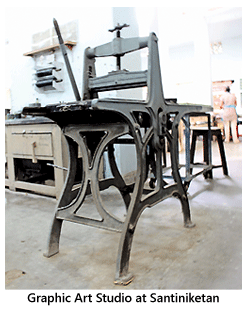 Print as a creative medium in India started during the second decade of the twentieth century. This new era in Indian art began with the establishment of Kala Bhavana in Santiniketan in 1919 by Rabindranath Tagore. When in 1921 Nandalal Bose took charge of Kala Bhavana, the newly established art college, the creative ambience received a new energy and an unprecedented chapter was added to the history of Indian art. Graphic art was introduced in the teaching program of Kala Bhavana right from the beginning. During 1921-22 French artist Madame Andre Karpeles visited Santiniketan. She was an expert in wood engraving and demonstrated the art at Kala Bhavana. Thus artists of Kala Bhavana became familiar with the technique of engraving, and for the first time engraving was practiced there. Andre Karpeles left Santiniketan after six months. It was during her visit that Ramendranath Chakravarty learned the technique of engraving, though Ramendranath and his fellow students had already gone through William Pearson's personal collection of original etchings and dry points made by the renowned British printmaker Muirhead Bone. But none was able to comprehend the technique,
Print as a creative medium in India started during the second decade of the twentieth century. This new era in Indian art began with the establishment of Kala Bhavana in Santiniketan in 1919 by Rabindranath Tagore. When in 1921 Nandalal Bose took charge of Kala Bhavana, the newly established art college, the creative ambience received a new energy and an unprecedented chapter was added to the history of Indian art. Graphic art was introduced in the teaching program of Kala Bhavana right from the beginning. During 1921-22 French artist Madame Andre Karpeles visited Santiniketan. She was an expert in wood engraving and demonstrated the art at Kala Bhavana. Thus artists of Kala Bhavana became familiar with the technique of engraving, and for the first time engraving was practiced there. Andre Karpeles left Santiniketan after six months. It was during her visit that Ramendranath Chakravarty learned the technique of engraving, though Ramendranath and his fellow students had already gone through William Pearson's personal collection of original etchings and dry points made by the renowned British printmaker Muirhead Bone. But none was able to comprehend the technique,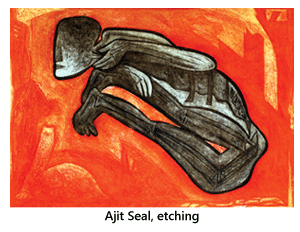 and it was Andre Karpeles who solved the problem.
and it was Andre Karpeles who solved the problem.
In 1923 the Mexican connoisseur Fryman visited Santiniketan. Though he was not a perfect printmaker he had had an opportunity to observe the technique of Japanese multi-colour woodcut process from a Japanese printmaker while he was in Paris. Fryman demonstrated his knowledge at Kala Bhavana. It was around 1925 that Ramendranath Chakravarty started experimenting with colour woodcut prints in Japanese multicolour technique similar to Ukiyo-e prints. Ramendranath wrote a letter to Andre Karpeles in Paris dated 19th January 1925 mentioning, "I am trying colour woodcut. Please give me advice how to print and with which colour. Give me the address where I can get woodcut materials."
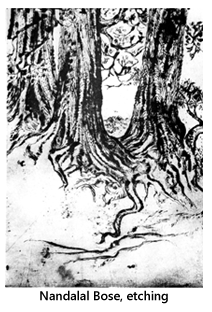
During the year 1925 Surendranath Kar, an artist-craftsman, technician and architect, went to London to learn the technique of lithography and etching. There in County Council he did a few lithographs and offset prints. Though Surendranath was unable to equip himself as an expert in lithography and etching, he was able to create an interest among other artists to start lithography and etching upon his return to Kala Bhavana. In 1926 Gaganendranath Tagore donated his litho press to Kala Bhavana and a pressman was appointed to look after it. However, lithography did not make much progress as there was no experienced artist or technician to look after the lithography establishment.
Ramendranath learned the primary techniques of lithography and etching from Surendranath. As a result of intense interest for lithographic print, Nandalal Bose drew up a program to publish a folio depicting Bengal dolls in colour lithography. After having four or five prints of different Bengal dolls printed in monochrome and stained in colour ink, the project did not work out, fully due to technological gaps. But we must pay our attention to the excitement that was created.  Surendranath was unable to pay much attention to the graphic section as he was busy with the various other developments at Visva-Bharati. When Surendranath left Kala Bhavana, Ramendranath tried his best to ensure a working atmosphere in the lithography studio. During this period Nandalal Bose, Ramendranath and a few artists of Kala Bhavana executed some lithographs but after a short while, the lithography section got closed due to lack of proper maneuvers. Ramendranath and a few artists continued etching and woodcuts.
Surendranath was unable to pay much attention to the graphic section as he was busy with the various other developments at Visva-Bharati. When Surendranath left Kala Bhavana, Ramendranath tried his best to ensure a working atmosphere in the lithography studio. During this period Nandalal Bose, Ramendranath and a few artists of Kala Bhavana executed some lithographs but after a short while, the lithography section got closed due to lack of proper maneuvers. Ramendranath and a few artists continued etching and woodcuts.
In 1924 Nandalal Bose visited China and Japan, and when he came back, there was an authentic collection of Chinese rubbings and Japanese colour woodcut prints with him. Artists of Kala Bhavana came into direct contact with the original prints of the Far East.
Nandalal's vision could immediately adapt this to the creative possibilities and scope of graphic art. He had experimented and worked with various printmaking media such as woodcut, wood engraving, linocut, etching, 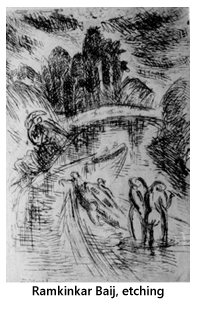 dry point, lithograph and even nontraditional matrix like cement block, following the rubbing and relief process. It is generally agreed that Pablo Picasso was the first to explore linoleum as a medium for artistic creative expression during the 1950s. But prior to Picasso's attempt, Nandalal Bose selected the linoleum block to illustrate Rabindranath's book called Sahaj Path, a Bengali alphabetical book for children printed in 1930-31. The linocut illustrations of that book are remarkable for their strong graphic characters. The linocuts of Sahaj Path should be considered as a turning point in the history of Indian creative print. The linocuts were based on simple design, clear arrangement of space with balanced distribution of black and white, and strong negative and positive forms.
dry point, lithograph and even nontraditional matrix like cement block, following the rubbing and relief process. It is generally agreed that Pablo Picasso was the first to explore linoleum as a medium for artistic creative expression during the 1950s. But prior to Picasso's attempt, Nandalal Bose selected the linoleum block to illustrate Rabindranath's book called Sahaj Path, a Bengali alphabetical book for children printed in 1930-31. The linocut illustrations of that book are remarkable for their strong graphic characters. The linocuts of Sahaj Path should be considered as a turning point in the history of Indian creative print. The linocuts were based on simple design, clear arrangement of space with balanced distribution of black and white, and strong negative and positive forms.
It is interesting to note that the art of paper cut is prevailing as traditional art among the Santal Community. 'Modoya' or 'mandap' is a bamboo roofless pavilion with four sides open, and is a place where generally marriage ceremonies take place. The bamboo arch is decorated with colourful paper cuts of daily life, animals, birds, foliage and animals. The negative area of the image is cutout by scissors or knife. While cutting away the negative images the four-sided border frame is kept, similar to stencil process or bas relief (like the temple terracotta plaques of Bengal).  The images are flat, silhouette, bold and contour-based images. In the work of Nandalal's Sahaj illustration we see the similar character of image making in terms of solid negative and positive space on paper. It is presumed that Nandalal might have seen such art of paper cut in the Santal community of surrounding Santiniketan.
The images are flat, silhouette, bold and contour-based images. In the work of Nandalal's Sahaj illustration we see the similar character of image making in terms of solid negative and positive space on paper. It is presumed that Nandalal might have seen such art of paper cut in the Santal community of surrounding Santiniketan.
The black & white linocuts of Nandalal had strong influence. Printing linoleum block was technically less complicated and easier to handle and it gives an attractive monochromatic image. It quickly became popular even at the school and was introduced to the syllabus. The school magazine Patha Bhavana is one of the brilliant examples, and the annual magazine Amadar Lekha was embellished with black & white linocuts done by the students.
Along with Ramendranath, his fellow student Manindra Bhusan Gupta was also interested in printmaking. Before he joined Kala Bhavana as a student he had his primary lesson on slate engraving while he was a student of Jagannath College in Dacca. On seeing his interest and skill on slate engraving Pearson presented him a box of wood cutting tools that had been brought directly from London. Manindra Bhusan started doing wood engraving and woodcut. During this period he created a series of woodcut prints, little in size, as New Year's greeting cards, which were printed specially for sale. Manindra Bhusan left Santiniketan in the year 1925. Biswarup Bose, another skilled printmaker went to Japan during 1935 to learn Japanese multi-colour woodcut technique. After his return a new chapter was added to the printmaking history of Kala Bhavana. Biswarup Bose made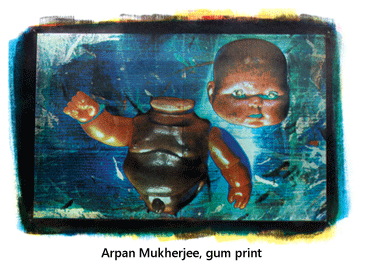 colour reproductions of indigenous pictures in Japanese woodcut technique.
colour reproductions of indigenous pictures in Japanese woodcut technique.
Ramendranath, Manindra Bhusan and Biswarup Bose were great experimentalists, their research attitude towards printmaking created an atmosphere of creative experimentation. If we look at their work, we will notice that there is a conflict between graphic media and the content and form they used. Their aim was to build up a picturesque effect on the graphic surface and for this reason most of their prints became more painterly than graphic. Though graphic was not merely a duplicative medium to them, they still lacked a proper understanding of the particular potentialities of the various surface effects of graphic media.
We see an important change in the approach towards graphics from this time onwards. For the first time Indian artists were not too concerned with the reproductive value of graphic media. In fact, they concentrated more on doing a 'complete' work by itself, which could stand out as an independent work of art. During this decade a different aim could be seen in the work of Benodbehari and Ramkinkar. Both these artists had experimented with various graphic media: woodcut, wood engraving, linocut, etching, drypoint, lithography and even with large cement blocks.
Benodbehari and Ramkinkar, the two outstanding pupils of Nandalal, executed a series of graphic prints 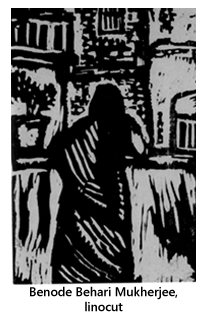 which are the most striking examples in the history of Indian art. Though trained under the "Bengal School", they departed from its influence by evolving their own- conception and style. In their works one could no longer see the romantically poetic and lyrical elements of the Bengal School, but their works became more precisely stylized and eclectic taking various styles and expressions of Indian, Far-Eastern and European origin. In the works of Benodbehari and Ramkinkar, well organized forms and textural values could be seen. Their departure from the Bengal School becomes conspicuous if their works are compared with the works of Ramendranath, Manindra Bhusan and others. One notices in the works of these three masters, the absence of mechanical details. Like Rembrandt, the great Dutch graphic master, their main efforts were towards a pictorial graphic surface; they never allowed the aesthetic possibilities of printmaking to be inhibited by rigid technical details.
which are the most striking examples in the history of Indian art. Though trained under the "Bengal School", they departed from its influence by evolving their own- conception and style. In their works one could no longer see the romantically poetic and lyrical elements of the Bengal School, but their works became more precisely stylized and eclectic taking various styles and expressions of Indian, Far-Eastern and European origin. In the works of Benodbehari and Ramkinkar, well organized forms and textural values could be seen. Their departure from the Bengal School becomes conspicuous if their works are compared with the works of Ramendranath, Manindra Bhusan and others. One notices in the works of these three masters, the absence of mechanical details. Like Rembrandt, the great Dutch graphic master, their main efforts were towards a pictorial graphic surface; they never allowed the aesthetic possibilities of printmaking to be inhibited by rigid technical details.
When Ramendranath left Santiniketan, Biswarup Bose became an effective teacher for the printmaking section. After his return from Japan he was able to create a new enthusiasm among the students to experiment with various graphic media. Before 1969, printmaking was merely a part of the department of painting. The relief process was widely taught at Kala Bhavana, and intaglio and planography were mainly for the advanced students. During this period woodcut, wood engraving, linocut and stencil processes were compulsory for the junior section and their works could be divided into three major groups; (1) Creative Printmaking, (2) Printed design and (3) Re-Production of Picture. In the first group,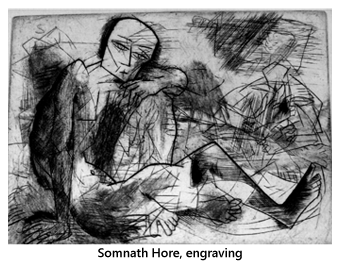 students were taught to create original prints mainly based on monochromatic matrix. Due to the lack of proper understanding of the medium their works became nearer to painting than being truly graphical. In the second group there were Alpana and design in woodcut and linocut. This was a period when Alpana of Kala Bhavana were well-known all over India for their oriental and decorative character. Alpana became a special interest among the students. In the third category, there were reproductions of Indian painting, especially mediaeval and contemporary paintings of reputed masters by means of colour woodcut and stencil process. For an example, Nara Venkat Ratnama executed a few colour reproductions of the paintings of Nandalal Bose in woodcut technique.
students were taught to create original prints mainly based on monochromatic matrix. Due to the lack of proper understanding of the medium their works became nearer to painting than being truly graphical. In the second group there were Alpana and design in woodcut and linocut. This was a period when Alpana of Kala Bhavana were well-known all over India for their oriental and decorative character. Alpana became a special interest among the students. In the third category, there were reproductions of Indian painting, especially mediaeval and contemporary paintings of reputed masters by means of colour woodcut and stencil process. For an example, Nara Venkat Ratnama executed a few colour reproductions of the paintings of Nandalal Bose in woodcut technique.
If we search the history of printmaking of Kala Bhavana from its early stage to 1967, we will notice that mediocre and less talented students were not being benefited by the teaching program, nonetheless a few talented students, namely, Nara Venkat Ratnama, Kripal Singh, Sankho Choudhury, Madhukar Sheth, Dinkar Kowshik, K G Subramanyan, G Dikshit, Jagdish Mittal, Gostto Behari, Banabehari Ghosh, and Binodh Rahut Roy were able to create something original, especially in woodcut and linocut. In the year 1967, when five year degree and diploma courses were started at Kala Bhavana under the guidance of Dinkar Kowshik, various changes took place. 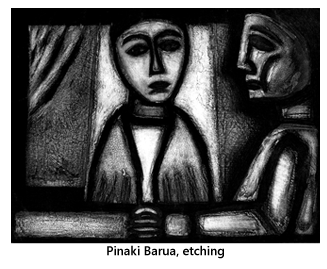 With the new syllabus of five year degree and diploma, the entire course of study was divided into four departments: (1) Painting (2) Graphic Art, (3) Sculpture, (4) History of Art and Aesthetics. Along with these four departments, the two years certificate course in crafts and design also continued. Every student had to join first the elementary course, and he had to work for three years to qualify himself to select any of the four specialized streams. Each of these four departments had a course and curriculum of two years at the specialization stage. Printmaking as a specialized course in the graduate level was introduced in India for the very first time. And a separate graphic section, with three sub-sections, (1) Relief process; woodcut wood engraving, linocut etc; (2) Planography: lithograph and Platography (commencing later, in 2005); (3) Intaglio; etching, engraving, drypoints, etc.
With the new syllabus of five year degree and diploma, the entire course of study was divided into four departments: (1) Painting (2) Graphic Art, (3) Sculpture, (4) History of Art and Aesthetics. Along with these four departments, the two years certificate course in crafts and design also continued. Every student had to join first the elementary course, and he had to work for three years to qualify himself to select any of the four specialized streams. Each of these four departments had a course and curriculum of two years at the specialization stage. Printmaking as a specialized course in the graduate level was introduced in India for the very first time. And a separate graphic section, with three sub-sections, (1) Relief process; woodcut wood engraving, linocut etc; (2) Planography: lithograph and Platography (commencing later, in 2005); (3) Intaglio; etching, engraving, drypoints, etc.
During the summer recess of 1968, Kala Bhavana arranged a graphic camp and invited artists like Somnath Hore, K G Subramanyan, A Ramachandran, Binodbehari, Ramkinkar and Sukhomoy Mitra. In this camp special interest was taken in lithography and etching. Somnath Hore joined as the head of the department of graphic arts in the year 1969. A renewed enthusiasm was created in the printmaking section under the expert guidance of Somnath Hore and Biswarup Bose. The first batch of students joined the department to be specialized in printmaking in the year 1970. Somnath Hore lost no time in introducing various techniques, 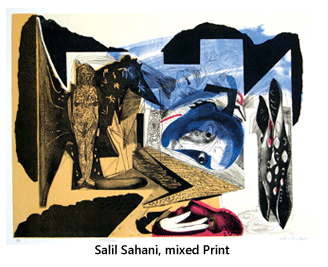 especially in lithography and etching. This was a period of experimentation with different graphic media. Somnath Hore and Biswarup Bose, the two great experimentalists, allowed and guided their students to explore graphic media with the attitude of research in the field.
especially in lithography and etching. This was a period of experimentation with different graphic media. Somnath Hore and Biswarup Bose, the two great experimentalists, allowed and guided their students to explore graphic media with the attitude of research in the field.
The popularity of the department increased. People gradually came to appreciate the standard of the printmaking section. In 1973 a silkscreen class for senior students was started under the supervision of Biswarup Bose. Tapan Mitra & Santanu Bhattacherjee devoted their full time to establish the serigraphy section in Kala Bhavana. But the project came to an end after a year due to not enough involvement of serious students in the section. The practice of serigraphy restarted again in 1990 is being continuing till date
The department has continuously been boosted up with people like S K David, Santanu Bhattacherjee, Lalu Prasad Shaw, Nirmalendu Das, Suranjan Basu, Pulak Dutta, Arpan Mukherjee, Ajit Seal and Salil Sahani joining the faculty. The Graphic Art Department of Kala Bhavana not only became an active centre for creative prints, but gradually enhanced new methods and materials and introduced those into the curriculum syllabus.
Images Courtesy: The Author